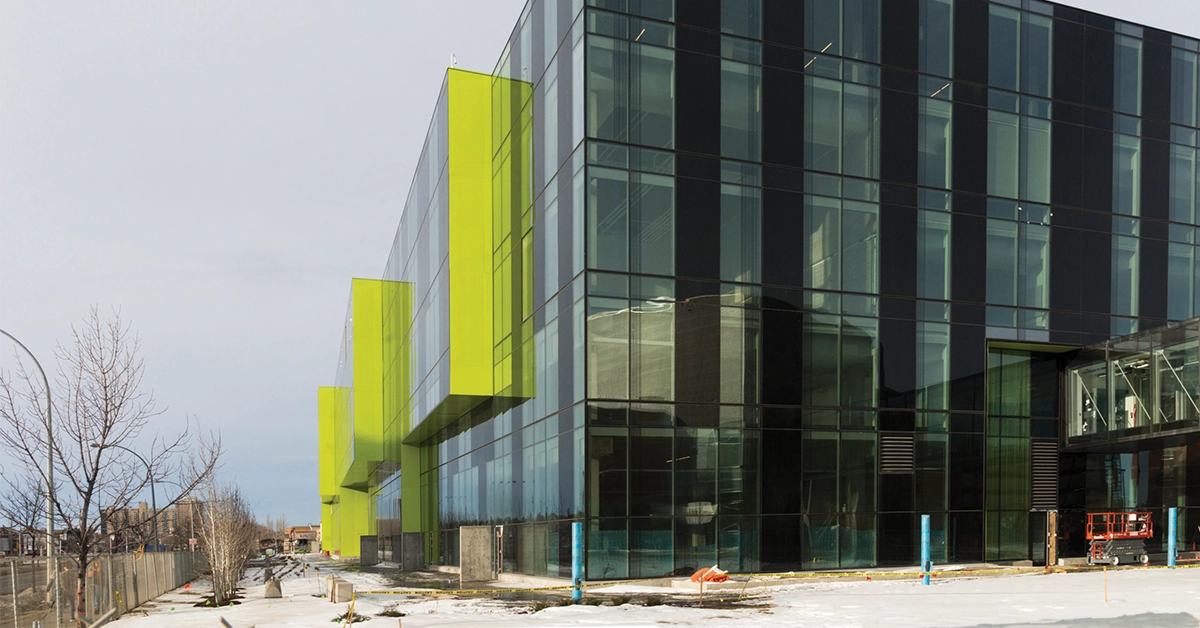For years, MacEwan University students who wished to pursue fine arts or communications studies were relegated to an unwieldy orange building in Edmonton’s west end.
Eventually, the communications studies people jumped ship to City Centre Campus (CCC), but the fine arts students stayed hidden away in a dingy region of ill repute.
That reality will be changing, though — this fall, the new Centre for Arts and Culture (CFAC) will open up right next to CCC. The building will, according to MacEwan’s website, encompass “40,000m² … of classroom, lab, exhibit … and performance space, along with state-of-the-art technology.”
“It sort of ful lls the longtime dream of having the entire university consolidated in one location, especially downtown,” associate Bachelor of Communication Studies (BCS) professor Peter Roccia says. “Before, it was kind of that ‘70s–’80s philosophy of satellite campuses.”
There could be some perceived favouritism in the allocation of space, though: in the new, five-storey building, the BCS program gets very little space. The rest is going to the other programs in the Faculty of Fine Arts and Communications (FFAC).
However, BCS program Chair Lucille Mazo does not see having separate buildings on the same campus as a separation (or, for that matter, an instant union) of programs, but as a bridging of a physical gap.
“I think it’ll take awhile for us to sort of merge and meld a bit,” she says, “but the way it stands right now is our relationship will probably be much the same, with some strengthening going on with close proximity.
“Proxemics, I guess.”
Assistant BCS professor Peter Roccia also points to the new name of the building — the Centre for Arts and Culture — as a sign that the building was not really meant for the BCS.
‘It really will bring great visibility to the university, and as a downtown university, visibility is first and foremost, I would say.’
-Lucille Mazo
“I mean, I teach my students how to read messages, interpret messages, and architecture has a message,” Roccia adds. “So, when you’ve got floors of fine and performing arts, and three to four dedicated rooms (for) communications, it doesn’t really justify having ‘Centre for Fine Arts and Communications’ on the name of the building.”
Mazo says there was a movement to keep the term “communication” in the new building’s name. This push was rejected by those in charge of the naming of the building. Ultimately, though, Mazo describes the end result of that as being acceptable — especially considering what the communications program got in return.
“ They did remove ‘communication’ from the naming of the building, but then they (left it in) the name of the faculty,” Mazo says. “So, we’ve got a Faculty of Fine Arts and Communications. So, I think there was sort of a bit of a trade-off there: our name isn’t on the building outwardly, but our name is on the name of the faculty.
“So, we are there, and we do exist.”
As for the new building itself, Mazo speaks of it positively.
“Well, I think it’s excellent,” Mazo says. “It’s excellent on several levels. … It really will bring great visibility to the university, and as a downtown university, visibility is first and foremost, I would say.”
Mazo explains that in a city with many other post-secondary institutions, it is important for MacEwan to “keep (its) place” in the scene.
“One way we can do that is to build more space and buildings to grow our size,” she says, “and the CFAC building is one of those (projects).
“For the university, it’s a great opportunity.”
As for the BCS specifically, Mazo notes the program has several offices and spaces in Building 7. It is not without space in MacEwan. Indeed, rather than annexing any more space for the program, Mazo put a greater emphasis on enriching the space the program already has.
“In fact, we’ve put that on our Capital Requests this year,” she says, “and if all things go well, we hope to get more cameras, a little bit more in the newsroom, get an editing suite and computers.”
Mazo says it was known “early on” that the new city-centre build- ing would be dedicated to the fine arts, and that the space in the building would be used primarily for fine arts and culture studios.
“From a program standpoint, the building itself really had very little space in terms of offering it to the communication program.”
Indeed, far from seeing this focus on the “F” and “A” in “Faculty of Fine Arts and Communications” as a snub, Mazo sees the move as beneficial to the whole FFAC.
“ That’s, again, visibility for our program or, basically, our faculty, and (it helps) to bring great visibility to the community,” she says.
Roccia also notes that communications has had its base moved all over MacEwan’s spaces throughout the years. Even when communications was a part of the now-defunct Performing, Visual, and Communication Arts (PVNCA) program, communications got physically shuffled around quite a bit.
“Within that time that we were in the downtown campus,” he says, “… we moved from Building 6 to Building 5 — on the ground floor — to Building 5 — on the second floor — to back to Building 6. Then, (we moved) to the west-end campus, CFAC, and then, back downtown.
“So, I mean, the communications program has been in many locations.”
It wasn’t always the case that fine arts and communications were faculty siblings. For a while, communications fell under the Faculty of Arts and Science (FAS). However, neither Mazo nor Roccia know why the switch was made.
“To this day, I don’t even know that answer,” Mazo says.
Between the two of them, Mazo and Roccia managed to come up with possible answers, ranging from a desire to group the applied professional communications degree program together with journalism and design (then part of the PVNCA program at CFAC) to a move to get funding for the Robbins Health Learning Centre by increasing use of the CFAC building.
Again, though, these are all “speculations,” as Roccia says and as both faculty members acknowledge.
“Speculation is a revered pastime amongst faculty and students,” Roccia says, laughing. “I think we’re trained to analyze things, so when there’s no answer, we try to create one.”
Whatever the case, though, the program’s closeness to the FAS is, to Roccia, another reason to stay in CCC.
“We were happy to stay in Building 7,” he says.
No one from FFAC’s other programs would comment on any of these matters in time for publication.
Cover photo by Matthew Jacula.





0 Comments